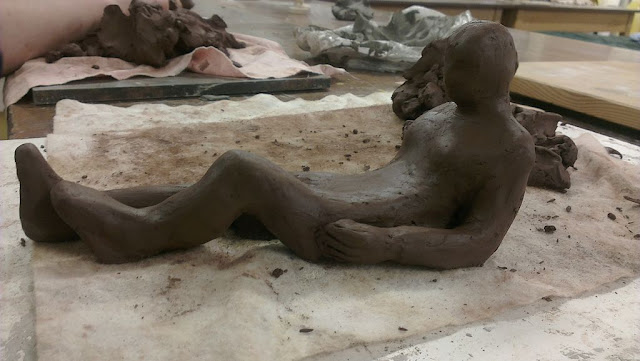The task was clear, I had to develop the given theme, in this case 'Classical Art and Architecture' by using multiple techniques, media and artist's research until having completed a final piece. Originally, I was quite pleased with the theme, Classical Architecture isn't something I've looked into before but it was something I'd read plenty about when I was a child. I went directly into the architecture area of the theme, seeing as it is what I plan on studying at university.
My research was gathered by visiting museums and galleries, the internet and books. This research was displayed in my sketchbook via photographs, mainly, and drawings of these photographs.
In one of my visits to the British Museum I discovered that, originally, Classical buildings were covered in a variety of brilliance, vibrance and colour. I found this extremely beautiful and seeing as I usually use black and white pens and only washed out hints of colour. Before, I'd never been too fond of colour as I always thought I had very little management and understanding of colour, when I'd use them the colours would hardly match, making the whole piece aesthetically unpleasant; I saw this project as an opportunity to improve this and I think I achieved a greater management.
I used a variety of media and techniqes, that I hadn't used (at all or on rare occasions); this includes: mono prints, lino prints, stencil prints (which I used for my exam piece), watercolours, watercolour pencil, gouache, oil bar, oil pastels, oil paints and acrylics. The oil pastels were my favorite to use, I thought them very easy to use. I'd used watercolours before but since my idea was to explore new media, I used them at a minimum, though the watercolour pencils gave a very pigmented hand-drawn effect. I ended up using a great variety of media for my final pieces. In my exam I made a lot of lino prints, enough to mount onto 9 A1 sheets of paper, I really like how they turned out and I'm submitting them as part of my final piece. Also, near the beginning of unit 2 I tried stencil prints, which was a lot of fun! I was surprised at the outcome, I'm really pleased them; I was focusing on classical columns and I wanted to give them an old, rusty effect so I used brown-yellows, deep reds and oranges and the occasional blues, greens and purples to add a bolt of colour. I made a painting too, this was mixed media on canvas; gouache, acrylics and a little bit of oil paints, it's not my best painting, but I like how I used the colours and lighting on the buildings. Like I mentioned before, I've never been to sure on using colour, especially not painting techniques so I used:
- 'Watercolour Challenge - Techniques inPractice' (published by Channel4 Books)
- 'The Acrylic Artist's Guide to Exceptional Colour' -Lexi Sundell (published by Search Press)
I found this book fantastic! It has simple guides to using colour and acrylics, the techniques (tonal value, the colour wheel and palettes, comparison of colour schemes, luminosity, temperature, etc) and artist's research displayed helped me a lot when using colour and acrylics on this project.
- 'Quick and Cleaver Acrylics' -Michael Sanders (published by David and Charles Books)
Not only did I experiment with materials, but also the effect of these materials on certain textures and backgrounds; rough and soft paint textures, different papers: stained paper was the best on to work with, I took A5 sheets of cartridge paper and stained one with coffee, this gave a really 'vintage paper' effect but it wasn't really pigmented, I stained another paper with red tea, this gave the paper a shiny sepia tone, a very pigmented one, I loved the effect.
Overall, I'm pleased with my developmental work, though I know I could have challenged myself more and done more experiments, finished off more of the tasks, and done more artist's research, as there's hardly any of that. I found that everything, the mounted workshop sheets and the final pieces express exactly what I wanted them to, Neo-classical buildings with colour, not necesarily the same colour or decoration that would have been seen during the original classical period, but any manifestation of colour, any expression that would differ to the plain Neo-classical buildings seen throughout Europe.


















